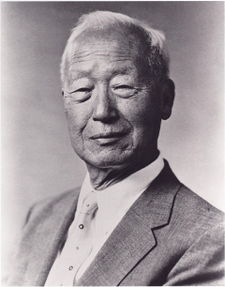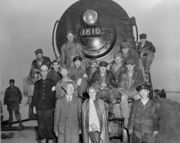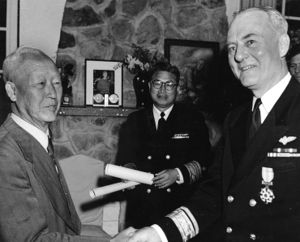Syngman Rhee
- This is a Korean name; the family name is Rhee.
| Syngman Rhee 이승만 李承晩 |
|
 Syng Man Rhee in 1956 |
|
|
1st President of the Provisional Government of the Republic of Korea
|
|
|---|---|
| In office September 11, 1919 – March 21, 1925 |
|
| Prime Minister | Yi Donghwi Yi Dongnyeong Sin Gyu-sik No Baek-rin Park Eunsik |
| Preceded by | Yi Dongnyeong (the 2nd Prime Minister of Provisional Government) |
| Succeeded by | Park Eunsik |
|
1st, 2nd and 3rd term President of the Republic of Korea
|
|
| In office July 24, 1948 – April 26, 1960 |
|
| Vice President | Yi Si-yeong Kim Seong-su Hahm Tae-Yong Chang Myon |
| Preceded by | Kim Gu (the last President of the Provisional Government), John Reed Hodge (military governor) |
| Succeeded by | Yun Po-sun |
|
|
|
| Born | April 26, 1875 Haeju, Hwanghae, Joseon Korea |
| Died | July 19, 1965 (aged 90) Honolulu, Hawaii, United States |
| Nationality | Korean |
| Political party | Liberal |
| Spouse(s) | Francesca Donner[1] |
| Religion | Methodism[2] |
| Signature |  |
Syngman Rhee or Yi Seungman (March 26, 1875 – July 19, 1965; Korean pronunciation: [i sɯŋman]) was the first president of South Korea. His presidency, from August 1948 to April 1960, remains controversial, affected by Cold War tensions on the Korean peninsula and elsewhere. Rhee was regarded as an anti-Communist and a strongman, and led South Korea through the Korean War. His presidency ended in resignation following popular protests against a disputed election. He died in exile in Hawaii.
Contents |
Early life
Syngman Rhee was born in Hwanghae Province to Yi Gyeong-seon, a royal aristocrat. By birth, Rhee was a member of a royal cadet branch of the House of Yi, the House of Grand Prince Royal Yangnyeong.[3][4][5] He attended Pai Chai Hak Dang, but he soon became active in Korea's struggle against Japanese hegemony. He was arrested in 1897 for demonstrating against the Japanese monarchy, being subsequently released in 1904 and going to the United States. He obtained several degrees (including a B.A. from George Washington University, Harvard University, and a Ph.D. from Princeton University) and became so Westernized that he began writing his name in the Western manner, with the personal name preceding the family name.
In 1910, he returned to Korea, which had by this time been annexed by Japan. His political activism attracted unwelcome attention from the occupying army. In 1919, all of the major pro-independence factions formed the Provisional Government of the Republic of Korea in Shanghai. Rhee was elected the president, a post he held for six years. In 1925 he was removed from office following his impeachment by the Provisional Assembly for misuse of his authority— an event that would foreshadow his later political career.
Rise to power
After Japanese rule ended in Korea, Rhee returned to Seoul before the other independence leaders. Since he was backed by the United States, he was appointed head of the Korean government in 1945. With America's tacit consent, Rhee began a campaign to "remove Communism". However it was actually a veiled plan to remove all political opposition.
Rhee won a seat at the First Assembly of South Korea on 10 May 1948 by one parliamentary vote after left-wing parties boycotted the election. He was elected as the Speaker of the Constituent Assembly on May 31. Rhee was then elected the first president of South Korea defeating Kim Gu, the last president of the Provisional Government by a margin of 82-13, on 20 July. On 15 August, Rhee formally took over power from the US military and de jure sovereignty of Korean people from the Provisional Government. A year later, Kim Gu was assassinated by Ahn Doo-hee. Some speculate that Rhee was behind this assassination.
Authoritarian
Rhee assumed dictatorial powers even before the Korean War broke out in 1950. He allowed the internal security force (headed by his right-hand man, Kim Chang-ryong) to detain and torture suspected Communists and North Korean agents. His government also oversaw several massacres, the most notable one being on Jeju island in which over 30,000 were killed in response to an uprising by leftist factions.
South Korea's Truth and Reconciliation Commission has estimated that the number of deaths attributed to these killings is at least 100,000 and perhaps upwards of 200,000.
Korean War
At the outbreak of hostilities in June 1950, the North Korean Army crossed the 38th parallel and made their way south, to Seoul in a rapid and unencumbered pace. Even though every South Korean resistance on the front was falling apart, Rhee forbade the military to reveal the truth of the situation to South Korean civilians, and instead, ordered them to give false reassurance and enthusiasm, going so far as stating that the South Korean army was pushing their way up to Pyongyang. By June 27, Rhee realized Seoul was in danger and decided to leave the city while ordering every radio station in Seoul to play a false recording which states that he would defend the city at all cost. With this reassurance, most of the civilians in Seoul remained aloof from the trouble, giving Rhee the opportunity to leave the city unhindered. By the time the civilians uncovered the ploy, Rhee had escaped from Seoul to Daejeon, while ordering the military to destroy all bridges on the Han River, thus condemning thousands of fleeing South Korean citizens in the process. On June 28th, North Korean soldiers conquered Seoul.
North Korean rule in Seoul was brutal. DPK soldiers would arrest any man with wealth or power--landlords, police, bankers, government officials--and execute them in public holdings. "In the name of the People", they would say and justify, before killing these men. Most of these condemned individual never had any formal trial. DPK soldiers also forced thousands of South Korean civilians into work camps, while also forcing them to join the Communist party by using hunger as their weapon.

After being forced back to the Pusan Perimeter, General Douglas MacArthur launched the Incheon landings in September 1950. The UN and South Korean forces then drove the North Koreans back across the 38th parallel towards the Yalu River. But following the intervention by Chinese volunteers, the UN and South Koreans were forced to retreat back to a line along the DMZ.
Rhee's relationship between the United States became tarnished after he refused to agree to a number of ceasefire proposals that would have ended the Korean War. Rhee wanted to become the leader of a unified Korea so he vetoed any plans that failed to destroy Kim Il-Sung. He also wanted stronger methods to be used against the government of Mao Zedong, expressing annoyance that the U.S. was reluctant to bomb China with nuclear weaponry.
Re-election
| Korean name | |
|---|---|
| Hangul | 이승만 or 리승만 |
| Hanja | 李承晩 |
| Revised Romanization | I Seungman or Ri Seungman |
| McCune–Reischauer | Yi Sŭngman |
| Pen name | |
| Hangul | 우남 |
| Hanja | 雩南 |
| Revised Romanization | Unam |
| McCune–Reischauer | Unam |
Rhee won the presidency for a second tenure in 1952. When the opposition-dominated National Assembly tried to amend the Constitution to institute a parliamentary system, Rhee countered with a bid of his own to transfer election of the president to the people. The amendment only passed when he jailed several opposition deputies before the vote. Shortly after his party regained control of the legislature in 1954, Rhee was able to pass an amendment exempting the incumbent president--himself--from the two-term limit.
Following the Korean War and for the remainder of his rule, he kept the Empress Dowager Empress Sunjeong of the Korean Empire imprisoned at Suin Hall, a cottage in Jeongneung, Seoul. Rhee feared that the South Korean population still revered her and opponents would use the Dowager Queen as a figurehead. Nevertheless, he made his own claims that he was related to the Royal family and the House of Yi.
Resignation and escape

In 1960, Rhee assured his fourth term in office as President with a resounding 90% of the vote. The landslide victory came after the main opposition candidate, Cho Byeong-ok, died shortly before the March 15 elections.
Nevertheless Rhee was determined to see his protégé Lee Gibung elected as the independent Vice President - a separate office under Korean law at that time. But when Lee, who was running against Chang Myon, former ambassador to the United States during the Korean War, won the vote with an abnormally wide margin the opposition claimed the election was rigged. This triggered anger among segments of the Korean populace. When police shot demonstrators in Masan, the student-led April 19 Movement forced Rhee to resign on April 26.
On April 28, a DC-4 belonging to the United States Central Intelligence Agency - operated by Civil Air Transport - whisked Rhee out of South Korea as protestors converged on the Blue House.
Kim Yong Kap, Deputy Minister of Finance accused Rhee of embezzling more than $20 billion in government funds. [6]
The former president, his Austrian-born wife, Franziska Donner, and adopted son then lived in exile in Honolulu, Hawaii.
Death

Rhee died of a stroke on July 19, 1965. A week later his body was returned to Seoul and buried in the Seoul National Cemetery.
Legacy and Analysis
Rhee's former Seoul residence, Ihwajang, is currently used for the presidential memorial museum. The Woo-Nam Presidential Preservation Foundation has been set up to honour his legacy.
Rhee is credited for his dictatorial and corrupt government. His reaction to any opposition is marked with brutality, going so far as allowing the police at Masan and Seoul to open fire at the strikers, killing more than a hundred individuals, and brutally murdering a high school student named Kim Ju-Yyeor(김주열). Like any strong man, Rhee was extremely authoritative, arresting any civilians who opposed him, whether a senator or a legislator, or a vagabond on the street. One of these instances occurred in Gyeongnam in May 27, 1952, where forty legislators were arrested by the military police simply because they were heading to the senate. A similar instance occurred in Masan in April 18, 1960, where Rhee secretly ordered the police and bribed criminal organizations to break up the strikers.
See also
- List of Korea-related topics
- President of South Korea
References
- ↑ "KOREA: The Walnut". TIME. March 9, 1953. http://www.time.com/time/magazine/article/0,9171,890478-3,00.html. "In 1932, while attempting to put Korea's case before an indifferent League of Nations in Geneva, Rhee met Francesca Maria Barbara Donner, 34, the daughter of a family of Viennese iron merchants. Two years later they were married in a Methodist ceremony in New York."
- ↑ The Walnut
- ↑ "Who Was Rhee Syngman?". http://www.hartford-hwp.com/archives/55a/186.html. Retrieved 2007-12-01.
- ↑ Korea
- ↑ Gyeongbokgong
- ↑ Selden, Mark (2003). War and State Terrorism: The United States, Japan and the Asia-Pacific in the Long Twentieth Century. Rowman & Littlefield. p. 110. ISBN 0742523918.
External links
| Political offices | ||
|---|---|---|
| First Establishment of the Republic
|
President of the Provisional Government of the Republic of Korea 1919 – 1925 |
Succeeded by Park Eunsik |
| Preceded by Kim Kyu-sik |
Chairmen of the Interim Legislative Assembly 1948 |
Succeeded by Himself as Speaker of the Constituent Assembly |
| Preceded by Himself as Chairmen of the Interim Legislative Assembly |
Speaker of the National Constituent Assembly 1948 |
Succeeded by Shin Ik-hee |
| Preceded by Kim Gu as President of the Provisional Government |
President of South Korea 1948 – 1960 |
Succeeded by Yun Boseon |
|
|||||||||
|
||||||||||||||||||||||||||||||||||||||||||||
|
|||||||||||||||||||||||||||||||||||||||||||||||||||||

